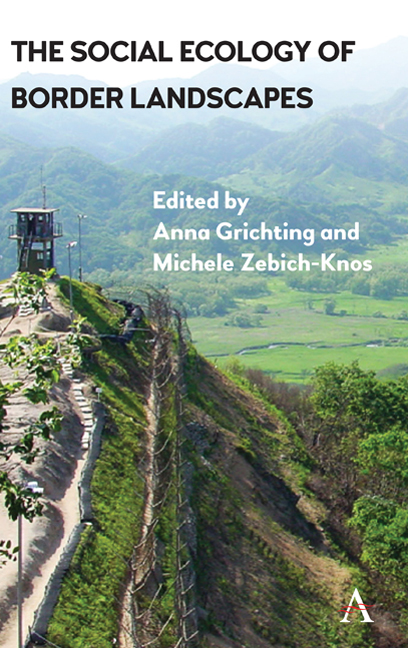Book contents
- Frontmatter
- Contents
- List of Illustrations
- Preface
- List of Contributors
- Introduction: Social Ecologies and Borderlands
- Part I FRAMES: MAPPING SOCIAL ECOLOGIES IN BORDER TERRITORIES
- Chapter One On the Agency of Borderlands
- Chapter Two Social Ecology and Transboundary Conservation: (Re)connecting Nature and People in Borderlands
- Chapter Three Social Ecologies and Structural Violence: Boundary-Making as Nature-Making in a Gated Globe
- Part II BRIDGES: RESILIENCE, RESTORATION AND RECLAMATION
- Part III CORRIDORS: CATALYSTS AND COLLABORATION IN CONFINED SPACES
- Part IV PORTALS: DIALOGUE, EXCEPTION AND RETERRITORIALIZATION
- Conclusion: Making Sense of Social Ecology, Borders and the Environment
- Index
Chapter Two - Social Ecology and Transboundary Conservation: (Re)connecting Nature and People in Borderlands
from Part I - FRAMES: MAPPING SOCIAL ECOLOGIES IN BORDER TERRITORIES
Published online by Cambridge University Press: 10 January 2018
- Frontmatter
- Contents
- List of Illustrations
- Preface
- List of Contributors
- Introduction: Social Ecologies and Borderlands
- Part I FRAMES: MAPPING SOCIAL ECOLOGIES IN BORDER TERRITORIES
- Chapter One On the Agency of Borderlands
- Chapter Two Social Ecology and Transboundary Conservation: (Re)connecting Nature and People in Borderlands
- Chapter Three Social Ecologies and Structural Violence: Boundary-Making as Nature-Making in a Gated Globe
- Part II BRIDGES: RESILIENCE, RESTORATION AND RECLAMATION
- Part III CORRIDORS: CATALYSTS AND COLLABORATION IN CONFINED SPACES
- Part IV PORTALS: DIALOGUE, EXCEPTION AND RETERRITORIALIZATION
- Conclusion: Making Sense of Social Ecology, Borders and the Environment
- Index
Summary
Introduction
Much has been done about mainstreaming the concept of social ecology into biodiversity conservation and protected area management, with conservation practitioners embracing the need to enhance the relevance of their discipline within broader social, political and economic realms. The most demonstrable example is evident in the 5th International Union for the Conservation of Nature (IUCN) World Parks Congress, held in Durban, South Africa in 2003, with the theme “Protected Areas: Benefits beyond Boundaries,” as well as its key messages, among which were the calls for:
• A new deal for protected areas, local communities and indigenous peoples.
• A need to apply new and innovative approaches for protected areas, linked to broader agendas.
As challenging as it may seem for conservation practitioners to integrate these approaches into their work, it remains simple where this work falls within national jurisdictions. However, where multinational processes are required, the levels of complexity increase substantially, as does the relevance for the application of social ecological principles and thinking. The recently published IUCN World Commission on Protected Areas (WCPA) Best Practice Protected Area Guidelines Series No. 23, titled Transboundary Conservation: A Systematic and Integrated Approach, states that approximately one-third of all terrestrial high biodiversity sites straddle national land borders, and it is therefore essential that neighboring states collaborate in their efforts to secure and protect these areas. While this statement still reflects a bio-centric bias, the Guidelines build on and expand the theme of the 5th IUCN World Parks Congress. They therefore serve as the basis from which this chapter has been compiled.
This chapter provides the reader with an indication of how transboundary conservation (TBC) may be used as a tool to facilitate social ecological processes and vice versa. It provides background information to contextualize TBC at the global scale before describing the principles and processes inherent in TBC initiatives, that is, what is necessary to get them going and to keep them going. Thereafter it provides insight into the linkages between the concept and social ecology before ending with thoughts and observations on the notion that TBC may be used as a mechanism to promote peace in border regions.
- Type
- Chapter
- Information
- The Social Ecology of Border Landscapes , pp. 37 - 52Publisher: Anthem PressPrint publication year: 2017

